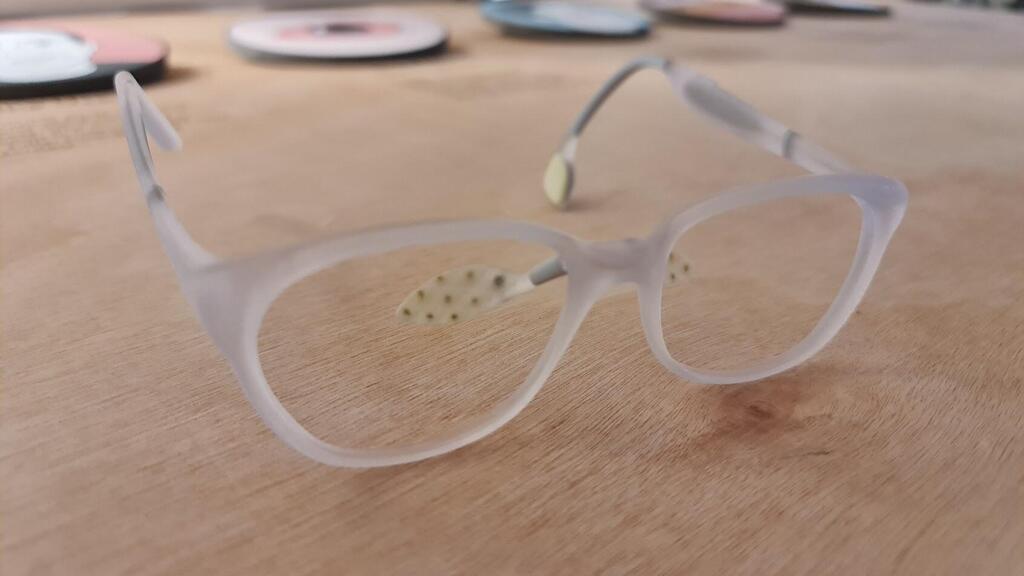Getting your Trinity Audio player ready...
Hundreds of millions of people worldwide, both adults and children, suffer from dry eye syndrome, but most are unaware of the surprising cause: they simply don't blink enough. On average, a person blinks every few seconds, around 15 times per minute. However, when we're staring at screens or performing tasks that require high concentration, the blinking rate significantly drops, causing dry eyes.
The Israeli startup BlinkAid has decided to tackle the issue by developing glasses that use electrical stimulation to encourage blinking. The company has filed patents globally and has a working prototype, aiming to launch the product within the next two years.
Three years ago, Raz Karl was a final-year student pursuing a dual degree in industrial design at Bezalel Academy of Arts and design and computer science at the Hebrew University. For his final project, he was required to design a new product, choosing to focus on the medical field. He had no idea that a few years later, this final project would evolve into a startup in the field of ophthalmology, where he would serve as the Chief Technology Officer (CTO).
When Raz received the assignment, he immediately sought advice from a friend's father, Dr. Yiftach Yasur, head of the Oculoplastic Unit at Rabin Medical Center. He asked if there was an eye-related problem he could help solve. Dr. Yasur, noting that "there's no shortage of problems," invited him to observe at the hospital.
Raz visited Beilinson Hospital, watched eye surgeries, and spoke with Dr. Yasur, Dr. Gal Antman, and Dr. Alon Tiosano from the hospital's eye department about the existing issues. "One topic that came up repeatedly was blinking, and I was a bit confused. I thought maybe it was an inside joke or something, but it turned out to be a very serious problem," Raz recalls of his first hospital meeting.
At that point, Raz decided to proceed with his project, aiming to be the first to offer a non-pharmaceutical solution to the problem, unlike the symptomatic treatments currently available on the market. "Many people suffer from this problem, and many are either unaware or not treating it properly," Raz said at the start of the conversation.
Dr. Yasur, the company's Chief Medical Officer, shared that the project began with an attempt to find a solution for people with blinking issues. He explained, "This problem usually appears in patients with facial nerve paralysis who don't blink at all. We initially thought we were going to treat these patients, but we gradually realized that the problem manifests itself, especially during the COVID-19 period, among all people spending long hours in front of screens."
He further explained that the blinking issue arises from the need for intense concentration, "We sometimes get so focused that we forget to blink. It's a reflex that we just stop using – when people are in front of screens, their blinking rate significantly decreases. For example, race car drivers, who require extremely high concentration, can reach a state where they don't blink for an entire minute."
A decrease in the rate and quality of blinking leads to dry eye disease, a condition receiving significant attention in ophthalmology. However, people suffering from dry eyes are often unaware of this irritating issue. "For people who work long hours in front of a computer, this is a very annoying phenomenon," Dr. Yasur said. "It starts as a minor irritation, but later on, the dry eye disease can cause significant harm. It creates inflammatory cells due to dryness and irritation, which damage the elements that produce tears, causing more dryness – and the cycle continues. It can eventually become a chronic disease with no cure."
Dr. Yasur explained, "The cornea of the eye is a very unique organ in the human body; it is completely transparent and has no blood vessels. Tears are constantly produced by glands in the eye, but production alone is not enough. Tears need the blinking motion to spread them across the cornea each time. Once the blinking reflex is impaired, the eye begins to suffer from symptoms like dryness, pain, redness, and blurred vision."
Despite the initial focus on patients with facial nerve paralysis, they soon realized it was a much broader problem. "Eventually, we concluded that the patient group includes all of us – people who use screens, as well as patients with Alzheimer's, Parkinson's, facial muscle paralysis, etc. Essentially, we moved from treating blinking to identifying and fully addressing the problem," said Dr. Yasur.
He further explained, "To determine if you have the problem, you need to know how often you blink. Typically, I can identify a case of dry eyes and assume the problem stems from insufficient blinking. But there is no device on the market that can definitively determine if the problem is caused by lack of blinking – there's no way to know." So, what can be done? "First, we want to know how often we blink. Moreover, even if I knew how often a person blinks, there's no practical way to make them blink more. I can recommend it, but there's no real practical treatment."
"What is currently done for these patients is to bypass the problem – by providing artificial tear drops and similar products," Dr. Yasur said. "But even that is somewhat limited because people usually don't adhere to it, and artificial tears don't contain all the necessary elements. Tears have many layers, including liquid, antibodies, fat, and protein, which are not present in artificial tears. Dry eyes have many causes, but the most common one is blinking, which is becoming more prevalent due to screen use. The natural solution is simply to make people blink more or secrete more tears in an efficient way."
Dr. Yasur also noted the importance of blinking quality. He said, "When you're focused, sometimes you blink, but the muscle that should relax doesn't actually do so because the blink isn't complete. In such a case, the lower part of the cornea doesn't get what it needs." He added that a clinical trial would soon take place at Beilinson Hospital. "It's scheduled to start in the coming weeks; we are waiting for the regulatory approval," he said.
He described the project's beginnings: "Our solution started with the idea that we could perhaps make people blink using electrical stimulation. This concept evolved into a product that can monitor the number of blinks, induce blinks, and do so in a way that is personalized to the user. The importance of personalizing the product is significant because the nerves we stimulate to induce blinking vary in their pathways for each person, even between the two sides of the face. The precise location where I need to induce the stimulus is in a very specific nerve, which could be just a few millimetres away from a nerve in one person or even in the same person’s other eye."
Raz added, "We first want to understand what is happening with the individual, for example, how often they blink. For comparison, while there are many common solutions today for counting steps, measuring heart rate, analyzing sleep patterns, etc., there is still no real solution that tells us how often a person blinks, whether their blinks are complete or partial, and how to improve them. The glasses we're developing do this; they listen to the body, learn blinking patterns using artificial intelligence, and provide their distribution throughout the day."
According to him, "They can tell us not only the quantity of blinks but also their quality. In addition to the diagnostic capabilities, the glasses also actively treat the issue and can cause a person to blink. The coolest part is that this is tailored to the individual patient. They contain sensors and transmitters connected to a dedicated app that supports the entire blinking system of the patient from end to end."
How exactly do the glasses detect that we’re not blinking enough?
Regarding detection, the glasses record electrical activity in the body and electrical signals passing through the nerves near the glasses. The electrical signal can be seen in real time on the app, and when a person blinks, we analyze the disturbance in the signal – this is how we determine the effectiveness of the blink," says Raz Karl. "Furthermore, the glasses can cause a person to blink either by a reminder or by actually stimulating the eye to close. To an observer, it may look like magic, but in reality, it happens through micro-currents, signals that pass from the device to the eye.
"As for the future, this technology is currently focused on dry eye problems, but it has the potential to solve many other issues," Raz added. "We collect signals from the body and analyze them with artificial intelligence to provide information on blinks, but we believe that with this technology, we will also be able to identify and provide insights on other activities such as eye movements, dozing off at the wheel, and various other behaviors we've already seen in the signal."
Yechiam Sapir, the CEO of the company, added that "The product developed so far already has many capabilities related to diagnosing the problem and providing personalized treatment. The core development and the initial target area are the eye care markets related to the dry eye problem." He said, "In terms of development, there is an array of electrodes in various sizes with different capabilities positioned around the frame of the glasses. The customer's initial encounter with the product involves a diagnostic process against a computer screen, which can be done through the glasses or our website and the computer camera.
"Once the user undergoes such a diagnostic process and the problem is clarified, a personalized treatment plan is tailored for them – a frame of glasses with the electrode and supporting software that provides the optimal solution for them," he added. "The first product the company intends to launch will be, as mentioned, glasses designed for prolonged use in front of screens. Our technology, combined with other existing solutions on the market for the problem, will offer the customer an all-in-one experience. Our technology, embedded within a frame of glasses that includes a corrective optical lens for these distances and a blue light filter, will provide a product that meets all the user's needs in this work environment.”






